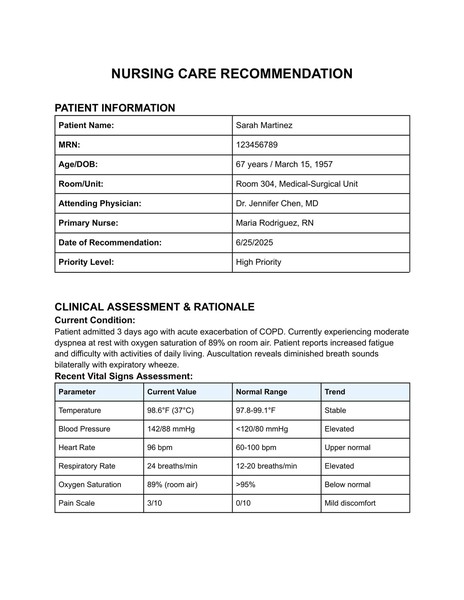This comprehensive nursing care recommendation template provides healthcare professionals with a structured framework for documenting patient assessments, clinical interventions, and care planning. The template includes detailed sections for patient information, vital signs tracking, risk assessment, and evidence-based nursing interventions.
Features
- Complete patient information and clinical assessment sections
- Structured vital signs and monitoring parameters table
- Priority-based nursing intervention recommendations
- Safety considerations and risk management protocols
- Interdisciplinary collaboration guidelines
- Outcome measures and evaluation criteria
- Documentation requirements checklist
- Professional signature approval section
Who Is This Template For
This template serves registered nurses, charge nurses, nurse practitioners, and healthcare teams working in medical-surgical units, intensive care, emergency departments, and specialty care areas. The template supports clinical decision-making, ensures comprehensive documentation, and facilitates communication between healthcare disciplines.
Use this template when developing individualized care plans, documenting complex patient conditions, preparing for interdisciplinary rounds, or creating standardized care protocols for specific diagnoses or clinical situations.
Format: Google Docs
Contributed by: Olivia Davis
How To Use
Access the template by clicking the "Use Template" button in the top right corner of the document page. A Google account is required to create a personal copy that can be edited and customized.
Replace all sample patient information with actual patient data, ensuring accuracy in medical record numbers, dates, and clinical details. Update vital signs tables with current patient values and adjust normal ranges based on individual patient factors or institutional protocols.
Customize the nursing interventions section to reflect specific patient needs and physician orders. Modify priority levels, frequencies, and rationales based on current clinical assessment findings. Remove interventions that do not apply to the specific patient situation.
Pay careful attention to safety considerations and monitoring parameters. Adjust alarm limits, notification criteria, and escalation protocols according to institutional policies and patient acuity level. Ensure all risk factors accurately reflect the patient's current condition.
Update the interdisciplinary collaboration section with appropriate team members and realistic timelines based on patient complexity and anticipated length of stay. Include specific consultation reasons that align with patient needs.
Review outcome measures and evaluation criteria to ensure they are measurable, realistic, and time-appropriate for the patient's condition and expected recovery trajectory. Modify documentation requirements to match institutional standards and regulatory compliance needs.
Verify that all evidence-based references remain current and applicable to the patient's diagnosis and treatment plan. Replace outdated guidelines with current best practice recommendations from professional nursing organizations.




